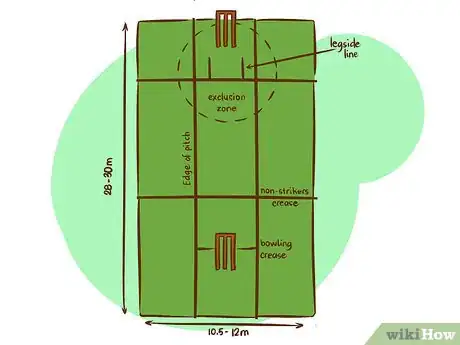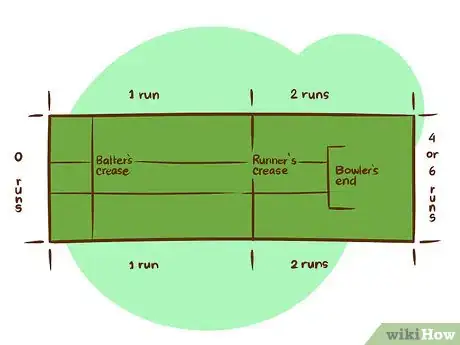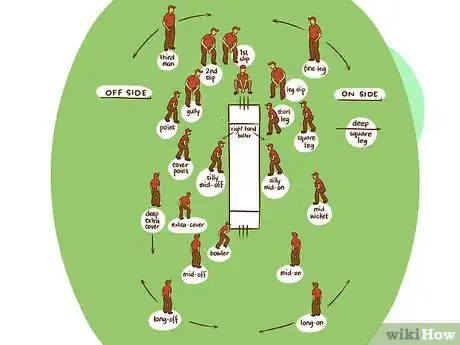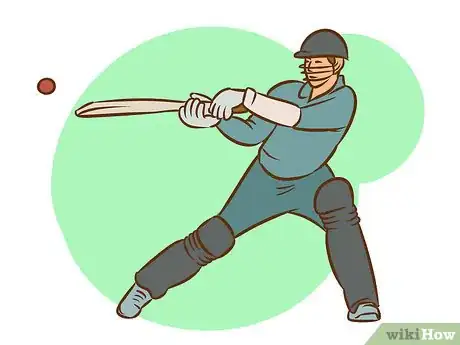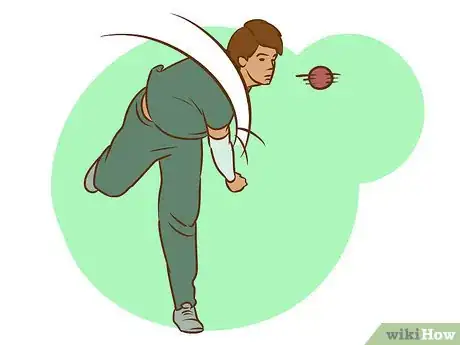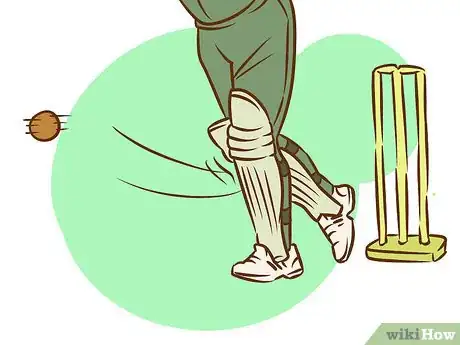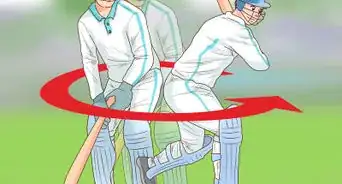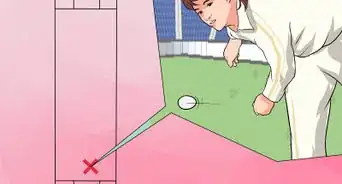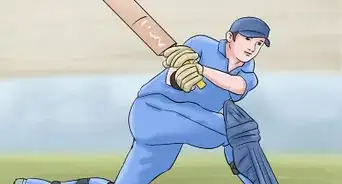wikiHow is a “wiki,” similar to Wikipedia, which means that many of our articles are co-written by multiple authors. To create this article, 11 people, some anonymous, worked to edit and improve it over time.
There are 7 references cited in this article, which can be found at the bottom of the page.
This article has been viewed 65,715 times.
Learn more...
Indoor cricket is an exciting variant of the classic game of cricket. Lasting only about 90 minutes, it is an excellent way for younger cricketers to get into the sport. Even experienced cricketers can play indoor cricket for practice when it’s too cold to go outside or just as a new challenge. Read this article and give indoor cricket a try!
Steps
International Indoor Cricket
-
1Get the playing arena ready. Any multipurpose sports hall with sufficient space can be used for this. An indoor cricket court must ideally measure 30 metres × 12 metres. Tight netting, about 4.5 metres high, should completely enclose the playing arena, a few metres from each side and end of the pitch. The pitch is the central strip between the wickets and should be 22 yards (20.12 m) long, just as in conventional cricket. Note that the non-strikers crease (or running crease) is only 11 metres from the striker’s crease. This basically means that the batsman only needs to run halfway down the pitch for a run. All other creases are in the regular position.[1]
-
2Make sure you have all the equipment.
- In conventional cricket, the stumps are stuck in the ground. As this won’t be possible indoors, you need to place a set of plastic spring-back stumps at each end of the pitch. These stumps will immediately spring back to the standing position when knocked over.
- For bowling, a modified cricket ball, with a softer centre is used. Unlike the red or white ball used in the traditional format, a yellow ball must be used in indoor cricket so that it is clearly visible indoors against varied backgrounds. For an amateur match, you could just use a tennis ball.
- For batting, traditional outdoor cricket bats and specialised indoor cricket bats that are lighter are both acceptable. The gloves may also be lightweight cotton with no protective padding on the outside. Team uniforms and additional protective gear (like elbow guards) can also be worn.
Advertisement -
3Form the teams. The 2 teams in indoor cricket generally consist of 8 players each. Everyone gets to bowl 2 overs and bat in a partnership for 4 overs. Thus, there will be 16 overs in one innings. If you want a faster game, or have lesser players, each side can be reduced to 6 players and each innings will last for 12 overs instead of 16. If there are 8 players in each team, the ball will be bowled 8 times in an over. In six-a-side matches, the usual rule of 6 balls per over is followed.[2]
-
4Start scoring. Just like in outdoor cricket, one team will bat first and the other team will field. In the second innings, the roles will be reversed. If your side is batting first, the goal is to score as many runs as possible. In indoor cricket, there are two ways to score- physical runs and bonus runs. For physical runs, both batsmen must complete a run from one crease to the other, that is, from the striker’s crease to the non-striker’s crease (or vice versa). As mentioned before, the batsman only needs to run halfway down the pitch and not the whole length. Bonus runs can be scored when the ball hits a net and vary, depending on which part of the net you hit.[3]
- Hitting the ball in Zone A (the front net, i.e., the net behind the wicket keeper) won’t get you any bonus runs.
- If the ball hits the net in Zone B (side nets between the striker's end and halfway down the pitch), you get 1 bonus run.
- If the ball hits the net in Zone C (side nets between the bowler’s end and halfway), you score 2 bonus runs.
- Hitting the ball in Zone D (the back net, i.e., the net behind the bowler) allows you to score 4 or 6 bonus runs depending on how the ball hits the back net. If the ball hits the net after bouncing, you get 4 bonus runs. If the ball hits the net without bouncing on the ground, you score 6 bonus runs.
- If the ball hits Zone B or C onto Zone D, you score 3 bonus runs.
- Remember that at least one physical run must be taken for any bonus runs to be scored. Whatever bonus runs you get will be added to the physical runs. For example, if you strike the ball into the front net for 1 bonus run and take 2 physical runs, you score a total of 3 runs off the ball.
-
5When it’s your turn to field, ensure that all the players are in the correct fielding positions. The indoor cricket court is divided into the front court and the backcourt and it is compulsory that 4 players of the fielding team are present in each half of the court when the ball is bowled. Keep in mind that the wicket keeper is included in the front court fielders and the bowler is included in the backcourt fielders.
-
6Restrict the rival team’s total. One effective way of doing this is to dismiss the opposing batsmen as quickly as possible. Dismissals take place in the same way as they do in conventional cricket, with a few differences.
- Unlike conventional cricket, the batsman continues to bat after getting dismissed in indoor cricket. Each pair of batsmen will bat for 4 overs, no matter how many times you dismiss them. However, 5 run will be deducted from the batting team’s total for each dismissal. If the player is dismissed, the physical or bonus runs that might have been awarded on that ball won’t be counted.
- The batsman is declared out if he/she strikes the ball and a fielder catches it before it touches the ground, just like in outdoor cricket. In addition to this, a player can also be dismissed if the ball is caught after rebounding off a net, as long as it has not previously touched the ground (except when a “six” is hit).
- The batsman can also be dismissed through the method of Mankad, which is much less common in outdoor cricket. This happens when the bowler completes the bowling action without actually releasing the ball and breaks the stumps at the bowling ending without letting go. If the non-striker is out of the crease, he/she is declared out.
- Leg before wicket (lbw) is a valid form of dismissal in indoor cricket but is does not occur as often as it does in outdoor cricket.
-
7Win the match. Both innings last for a full 16 overs (or 12 in six-a-side matches) and the team which has the higher score after both innings have been played is the winner of the match. If the totals are tied, the skin system can be followed. In this system, the batting partnerships from each innings are compared against one another and the higher of the two is declared the winner of the ‘skin’. If the third batting pair (5th player and 6th player) of your team scores, say 20, and the third batting pair of the other team scores 15, then your team wins the skin. The team that wins the most skins out of the four skins available will be declared the winner if the totals are tied.
UK Variant
This version of indoor cricket is more similar to conventional cricket than the netted version that’s internationally played. To play this type of indoor cricket, you need 6 players on each side.
-
1Obtain the requisite equipment. The cricket bats, team uniforms and protective equipment are similar to the ones used in outdoor cricket. Just as in conventional cricket, a hard ball and a full length pitch (22 yards) is used. If necessary, a mat may be rolled out on the floor of the arena to replicate the playing conditions of an outdoor pitch. Since the game is indoors, collapsible spring-loaded stumps are used instead of regular stumps. Any sports hall of suitable size or similar shaped indoor room can serve as the playing arena.[4]
-
2Understand the basics. The side which is batting must score runs by hitting the ball while the fielding side attempts to restrict the total score and dismiss the player. Both sides get a chance to bat. The team that has the higher score at the end of the match wins. These basic rules are the same in both indoor and outdoor cricket.
-
3Bowl well as the fielding team. All six players in the team don’t have to bowl. There can be a maximum of ten overs of six balls in an innings. Every over takes place from the same end of the pitch which is the central strip between the wickets. One bowler can bowl a maximum of three overs. In addition to conventional methods of dismissal, a batsman can be declared out if the ball, bouncing directly off the side wall (but not touching the floor or roof), is caught.
-
4Score for your team. The rules of indoor cricket are almost identical to outdoor cricket. However, there are a few exceptions to this, most notably the means of scoring.[5]
- If you strike the ball and it straightaway hits the back wall (“boundary wall”) behind the bowler without touching the floor or any part of the wall or roof, you will score six runs. If it touches the floor but not any other wall or the roof, you get four runs.
- If the ball is struck to hit one or more of the side walls, one run will be awarded, even if the ball subsequently hits the boundary wall.
- If you strike the ball in such a way that it directly hits the roof, it would be immediately declared a dead ball. This means that there will be no dismissal and no runs scored on that delivery. The ball won’t be re-bowled. However, if the ball hits the roof after it hits a wall, it’s still in play.
- When the batsmen complete a run physically, that is, run from one crease to the other, two runs will be scored. These two runs can be scored on top of a run for hitting a side wall but are not counted when a boundary (six or four) is hit.
- After reaching a personal total of twenty-five runs, the batsman must retire. However, if the rest of the team is dismissed before ten overs are completed, the batsman is allowed to return. If five wickets are lost within ten overs, the last player will continue batting and the fifth player who was out will remain as a runner.
References
- ↑ https://www.dlgsc.wa.gov.au/sport-and-recreation/sports-dimensions-guide/cricket
- ↑ http://www.worldindoorcricketfederation.com/download/2018%20Official%20Rules%20of%20Indoor%20Cricket_WICF%20Final%20.pdf
- ↑ http://www.worldindoorcricketfederation.com/download/2018%20Official%20Rules%20of%20Indoor%20Cricket_WICF%20Final%20.pdf
- ↑ https://www.brisbanecityindoorsports.com.au/basic-sport-rules/indoor-cricket-rules
- ↑ https://www.brisbanecityindoorsports.com.au/basic-sport-rules/indoor-cricket-rules
- https://en.wikipedia.org/wiki/Cricket_pitch
- https://en.wikipedia.org/wiki/Indoor_cricket
- https://en.wikipedia.org/wiki/Indoor_cricket_court
- https://en.wikipedia.org/wiki/Indoor_cricket_(UK_variant)
Community Q&A
-
QuestionWhat size is an action cricket ball?
 Community AnswerThe ball, when new, should weigh not less than 5½ ounces/155.9 g, nor more than 5¾ ounces/163 g, and shall measure not less than 813/16 in/22.4 cm, nor more than 9 in/22.9 cm in circumference.
Community AnswerThe ball, when new, should weigh not less than 5½ ounces/155.9 g, nor more than 5¾ ounces/163 g, and shall measure not less than 813/16 in/22.4 cm, nor more than 9 in/22.9 cm in circumference. -
QuestionWho invented cricket?
 Community AnswerThe origins of cricket are not fully known, but games similar to cricket have been played in Kent as far back as 1300, as documented in the household accounts of King Edward I. The first recorded match of cricket was played in Kent in 1646, and the first description of a cricket game comes from 1706.
Community AnswerThe origins of cricket are not fully known, but games similar to cricket have been played in Kent as far back as 1300, as documented in the household accounts of King Edward I. The first recorded match of cricket was played in Kent in 1646, and the first description of a cricket game comes from 1706. -
QuestionWhat happens if you miss the ball three times in a row in indoor cricket?
 Community AnswerIt depends on the type of cricket you are playing. If it is a First Class Cricket game, then there is no rule against it. In some street cricket matches, you can be taken out of the game.
Community AnswerIt depends on the type of cricket you are playing. If it is a First Class Cricket game, then there is no rule against it. In some street cricket matches, you can be taken out of the game.
Things You'll Need
- 2 sets of plastic spring-back stumps
- A tennis ball (with or without hard cricket ball casing) if you're playing the international version
- A cricket ball if you're playing the UK version
- Cricket bats (can be specialised in the international version)
- Helmets, leg guards and other protective gear
- Team uniforms (optional)
- A mat for the pitch (optional)
About This Article
Indoor cricket is a fun sport that you play in an enclosed, netted area between 2 teams (with 8 players on each team). The goal of the game is to score more runs than the opposing team over the course of 2 innings. Each player must bowl 2 overs and bat in a partnership for 4 overs. An innings lasts for 16 overs. To begin, flip a coin or decide which team will bat during the first inning. The fielding team puts on gloves and takes up their positions in the field in either the front court or the backcourt. 4 players of the fielding team must be present in each half of the court when the ball is bowled. The wicket keeper is included in the front court fielders and the bowler is included in the backcourt fielders. Once everyone is in place, the umpire calls “Play” to start the game. If your side is batting first, the goal is to score as many runs as possible. There are 2 ways to score – physical runs and bonus runs. To score a physical run, both batsmen must complete a run from the striker’s crease to the non-striker’s crease (or vice versa). Batsman only needs to run halfway down the pitch (instead of the whole length like in outdoor cricket). A batsman is declared "out" if they strike the ball and a fielder catches it before it touches the ground. Additionally, a player can be dismissed if the ball is caught after rebounding off a net. At least 1 physical run must be taken before any bonus runs can be scored. To score a bonus run, the batsman must hit the ball into the net. The field is divided into scoring zones which dictate how many bonus runs you get. Hitting the ball in Zone A (the front net behind the wicket keeper) doesn’t earn you any bonus runs. If the ball hits the net in Zone B (side nets between the striker's end and halfway down the pitch), you get 1 bonus run. If the ball hits the net in Zone C (side nets between the bowler’s end and halfway), you score 2 bonus runs. Hitting the ball in Zone D (the back net behind the bowler) allows you to score 4 or 6 bonus runs depending on how the ball hits the back net. If the ball hits the net after bouncing, you get 4 bonus runs. If the ball hits the net without bouncing on the ground, you score 6 bonus runs. If the ball hits Zone B or C onto Zone D, you score 3 bonus runs. After the first inning, the teams switch places so the fielding team gets a chance to bat. Both innings last for a full 16 overs and the team with the highest score after both innings have been played wins the game.
